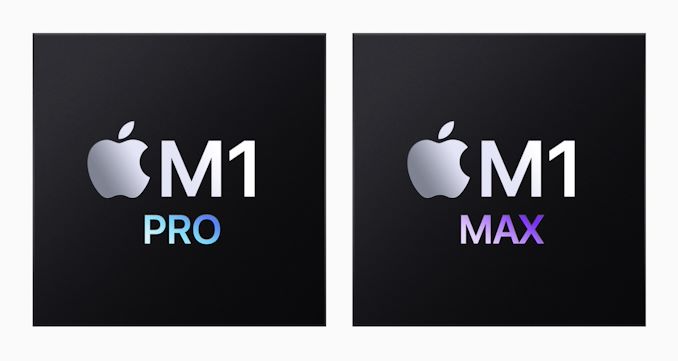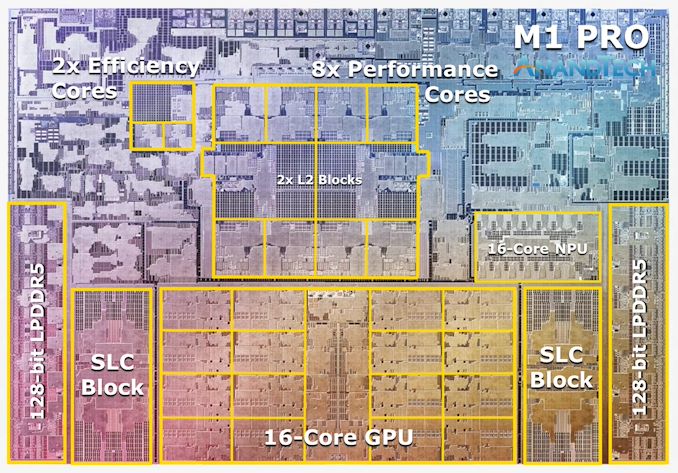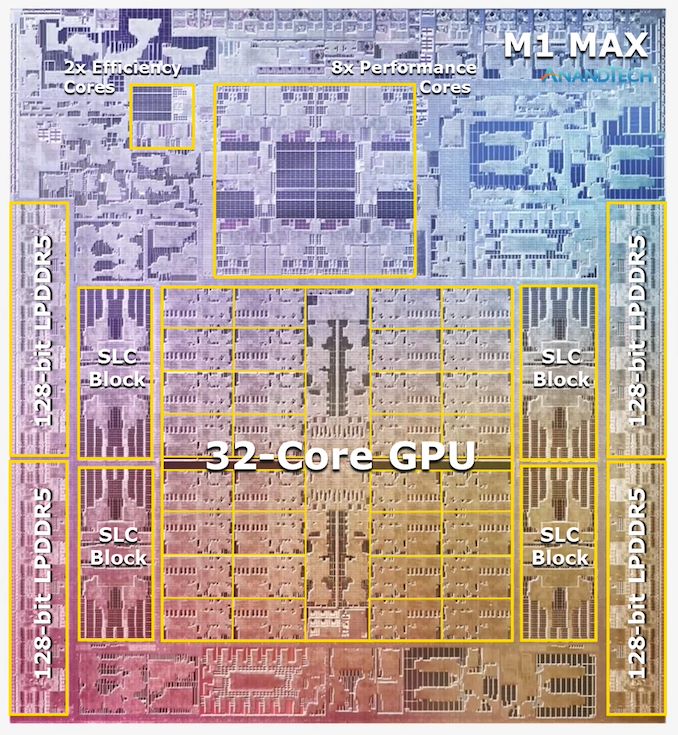Apple's M1 Pro, M1 Max SoCs Investigated: New Performance and Efficiency Heights
by Andrei Frumusanu on October 25, 2021 9:00 AM EST- Posted in
- Laptops
- Apple
- MacBook
- Apple M1 Pro
- Apple M1 Max

Last week, Apple had unveiled their new generation MacBook Pro laptop series, a new range of flagship devices that bring with them significant updates to the company’s professional and power-user oriented user-base. The new devices particularly differentiate themselves in that they’re now powered by two new additional entries in Apple’s own silicon line-up, the M1 Pro and the M1 Max. We’ve covered the initial reveal in last week’s overview article of the two new chips, and today we’re getting the first glimpses of the performance we’re expected to see off the new silicon.
The M1 Pro: 10-core CPU, 16-core GPU, 33.7bn Transistors
Starting off with the M1 Pro, the smaller sibling of the two, the design appears to be a new implementation of the first generation M1 chip, but this time designed from the ground up to scale up larger and to more performance. The M1 Pro in our view is the more interesting of the two designs, as it offers mostly everything that power users will deem generationally important in terms of upgrades.
At the heart of the SoC we find a new 10-core CPU setup, in a 8+2 configuration, with there being 8 performance Firestorm cores and 2 efficiency Icestorm cores. We had indicated in our initial coverage that it appears that Apple’s new M1 Pro and Max chips is using a similar, if not the same generation CPU IP as on the M1, rather than updating things to the newer generation cores that are being used in the A15. We seemingly can confirm this, as we’re seeing no apparent changes in the cores compared to what we’ve discovered on the M1 chips.
The CPU cores clock up to 3228MHz peak, however vary in frequency depending on how many cores are active within a cluster, clocking down to 3132 at 2, and 3036 MHz at 3 and 4 cores active. I say “per cluster”, because the 8 performance cores in the M1 Pro and M1 Max are indeed consisting of two 4-core clusters, both with their own 12MB L2 caches, and each being able to clock their CPUs independently from each other, so it’s actually possible to have four active cores in one cluster at 3036MHz and one active core in the other cluster running at 3.23GHz.
The two E-cores in the system clock at up to 2064MHz, and as opposed to the M1, there’s only two of them this time around, however, Apple still gives them their full 4MB of L2 cache, same as on the M1 and A-derivative chips.
One large feature of both chips is their much-increased memory bandwidth and interfaces – the M1 Pro features 256-bit LPDDR5 memory at 6400MT/s speeds, corresponding to 204GB/s bandwidth. This is significantly higher than the M1 at 68GB/s, and also generally higher than competitor laptop platforms which still rely on 128-bit interfaces.
We’ve been able to identify the “SLC”, or system level cache as we call it, to be falling in at 24MB for the M1 Pro, and 48MB on the M1 Max, a bit smaller than what we initially speculated, but makes sense given the SRAM die area – representing a 50% increase over the per-block SLC on the M1.
The M1 Max: A 32-Core GPU Monstrosity at 57bn Transistors
Above the M1 Pro we have Apple’s second new M1 chip, the M1 Max. The M1 Max is essentially identical to the M1 Pro in terms of architecture and in many of its functional blocks – but what sets the Max apart is that Apple has equipped it with much larger GPU and media encode/decode complexes. Overall, Apple has doubled the number of GPU cores and media blocks, giving the M1 Max virtually twice the GPU and media performance.
The GPU and memory interfaces of the chip are by far the most differentiated aspects of the chip, instead of a 16-core GPU, Apple doubles things up to a 32-core unit. On the M1 Max which we tested for today, the GPU is running at up to 1296MHz - quite fast for what we consider mobile IP, but still significantly slower than what we’ve seen from the conventional PC and console space where GPUs now can run up to around 2.5GHz.
Apple also doubles up on the memory interfaces, using a whopping 512-bit wide LPDDR5 memory subsystem – unheard of in an SoC and even rare amongst historical discrete GPU designs. This gives the chip a massive 408GB/s of bandwidth – how this bandwidth is accessible to the various IP blocks on the chip is one of the things we’ll be investigating today.
The memory controller caches are at 48MB in this chip, allowing for theoretically amplified memory bandwidth for various SoC blocks as well as reducing off-chip DRAM traffic, thus also reducing power and energy usage of the chip.
Apple’s die shot of the M1 Max was a bit weird initially in that we weren’t sure if it actually represents physical reality – especially on the bottom part of the chip we had noted that there appears to be a doubled up NPU – something Apple doesn’t officially disclose. A doubled up media engine makes sense as that’s part of the features of the chip, however until we can get a third-party die shot to confirm that this is indeed how the chip looks like, we’ll refrain from speculating further in this regard.














493 Comments
View All Comments
Ppietra - Monday, October 25, 2021 - link
The number of transistors doesn’t say what is price because, like you said, they are not manufactured on the same node, nor even by the same company, so you have no idea what is the difference in yields for the manufacturing process used.Secondly the 3090 is actually much bigger than the M1 Max (630 mm^2 vs estimated 430 mm^2), and it’s the area that affects the yield per wafer on that node.
Thirdly you still have no idea what is the actual cost of the 3090 chip, so you don’t have a clue for the price of M1 Max to base your argument on.
sirmo - Monday, October 25, 2021 - link
TSMC discloses scaling between different nodes (84% better density from 7nm-5nm). So we have a pretty good idea. I am 100% sure M1 Max is more expensive to manufacture than 3090.Ppietra - Monday, October 25, 2021 - link
:S what are you talking about!??? We know the size of the 3090 and we already have an estimate for the M1 Max based on the size of M1. The 3090 is much much bigger.And it is not enough to be more expensive than the 3090, you actually need a very high cost value for your argument about subsidies to make any sense - and by the way you haven’t given any value that would make a case for it!
sirmo - Monday, October 25, 2021 - link
5nm is 84% denser than 7nm, and even more so compared to Samsung's 8nm. Which is why transistor count is easier to understand.Ppietra - Monday, October 25, 2021 - link
you continue to make no sense! What matters when talking about yields is die size. Transistors count doesn’t tell you anything about yields when comparing chips using different manufacturing processes.vlad42 - Monday, October 25, 2021 - link
The price per transistor has generally been on the rise since post 14nm. So, just because the 3090 is larger, that does not mean it is more expensive.Also, I would not say the M1 Max MacBook Pro is being sold at a loss, but I would bet that the upgrade cost from the M1 Pro is less than then cost difference between the two chips. That is to say, I think Apple's margins on the M1 Max MacBook Pro are less than the M1 Pro MacBook Pro (or the margins from the other extra components such as memory are making up for it).
valuearb - Tuesday, October 26, 2021 - link
The higher the price point the higher Apples margins are, that’s always been true. The margin on the $1999 14 inch M1 Pro MBP is always going to be less than margins on a $3500 16 inch M1 Max MBP.Think about it. It’s basic pricing strategy. The high end buyers aren’t as price sensitive, have higher disposable income, earn more from their MBP investment, etc.
Ppietra - Tuesday, October 26, 2021 - link
vlad42, never have I said that the 3090 is more expensive... my argument is that you cannot say that the M1 Max is more expensive just because it has more transistors - yields are affected by dye area which affects the price and there are other factors that affect price too. As for the price per transistor info, that is assuming the yield is always the same.They charge 400 dollars more just to upgrade to the M1 Max. Considering the size of the M1 Max that would give around 130 chips per wafer, the price per wafer should be around 17,000 dollars (according to some estimates). That would mean 130 dollars per chip at 100% yield. An extra 400 dollars should be more than enough to cover a low yields and packaging.
valuearb - Tuesday, October 26, 2021 - link
And Microsoft puts 15B transistors in a $500 gaming device. I’m thinking a $3,000 laptop has plenty of margin to cover those big wafers.valuearb - Tuesday, October 26, 2021 - link
Apple never sells at a loss, always prices for high margins, and has zero reason to change that now given the new MBPs were instantly back ordered. Underpricing would be leaving mass amounts of money on the table.